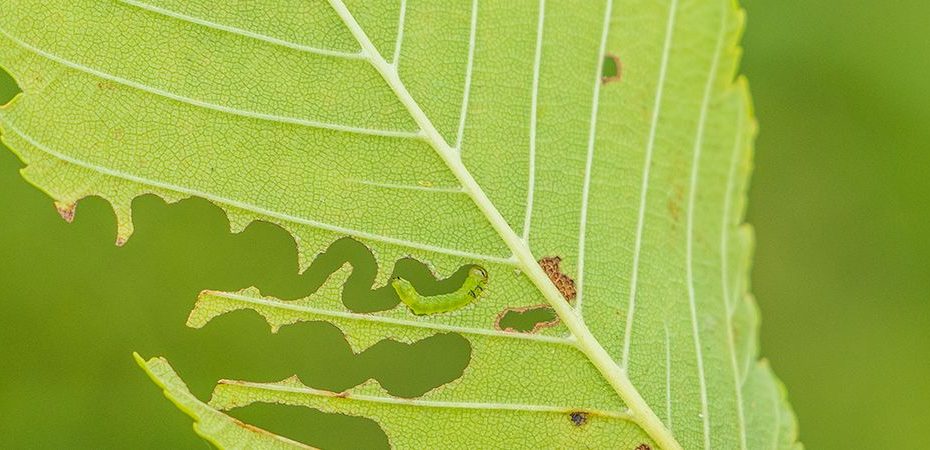Invasive species are a major contributor to biodiversity loss, and new arrivals are a particular concern. However, some invasive species get more attention than others. You may have heard about the spotted lanternfly or the box moth, two introduced insects currently spreading across Southern Ontario. Agencies like the Canadian Food Inspection Agency are actively tracking these species, trying to contain them, because they affect horticulture and agriculture, and thus have measurable economic impact. However, the spotted lanternfly is hosted by a non-native tree, while the box moth only eats a non-native, ornamental shrub, and has no impact on native wildlife.
Another new invasive species, the elm zigzag sawfly, is not getting the same attention. It was first detected in Canada in 2020, near Montreal. The larvae of this insect resemble small green caterpillars, and feed on the leaves of elm trees. As they feed, the larvae carve a distinctive path between the veins on a leaf, weaving back and forth – the reason for “zigzag” in the common name. Because of this unique path, known as a feeding trace, the presence of the small insect is relatively easy to spot.
A larval elm zigzag sawfly can be seen in a distinctive feeding trace on a small American elm leaf. Taken in Morris Island (near Arnprior) © Jakob Mueller
Unlike the spotted lanternfly and the box moth, the greatest threat posed by the elm zigzag sawfly, or EZS for short, is to native tree species. The immediate effect is harder to measure in dollars, but the resulting impact to native ecosystems is more insidious, and potentially severe.
The Ottawa Field Naturalists’ Club (OFNC) has made checking elms for e a priority. Over the past four years, OFNC surveys have traced the spread of the insect across eastern Ontario and into the Greater Toronto Area. The severity of the damage from EZS increases with time, progressing from cosmetic leaf damage to the full defoliation of trees. Initially, EZS prefers American elm, the most common of Ontario’s three native elm species. However, the insect eventually starts to feed on both slippery elms and rock elms as well, which are much less common.
Several leaves on this American elm twig in Larose Forest have feeding damage from elm zigzag sawflies. Once the larvae double-back on their feeding traces, the distinctive zigzag pattern becomes less obvious © Jakob Mueller
Seeing dead or diseased elms is already not unusual, and that’s part of the problem. All three native species are already affected by Dutch elm disease, an invasive fungal pathogen. Healthy mature elm trees, once common in the landscape, are already hard to find today. The presence of zigzag sawflies puts more pressure on these trees, which are already struggling to recover.
However, beyond just the trees, there is a cascade of ecological effects. Many species of native, non-harmful insects depend on elms for food, and those insects in turn provide food for other creatures. Some of these insects – including a native sawfly – have large caterpillars, which are important protein sources for breeding birds.
Leaf damage from EZS becomes extensive when the insect has been present for only a few years. Here, leaves on the right and bottom have early-stage feeding traces, while the leaf on the left has extensive damage. Heavy EZS feeding will skeletonize a leaf between the veins, sometimes creating a “fishbone” appearance. This photo was taken in Charlottenburg Park (near Cornwall) © Jakob Mueller
EZS is likely found across Southern Ontario now, and it’s important to keep tabs on it and the damage it does. The OFNC is part of Ontario Nature’s Nature Network, and the surveys that have kept track of EZS have been done by volunteers.
You can help too. If you see leaf damage that looks like EZS, take a picture (or several) and add it to the iNaturalist. It also helps if you take pictures of the tree (try to show multiple features like the leaves, twigs, bark, and form) and post it as an observation. This monitoring adds up, and the data can help convince agencies to assign more resources to help find solutions.
Resources
The post The Elm Zigzag Sawfly: A New Invasive Threat to Native Trees appeared first on Ontario Nature.
